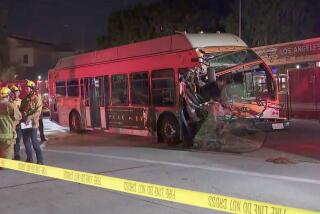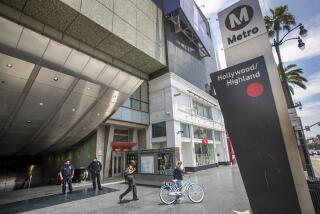Passenger Train Cars Plunge Off Overheated Tracks
KENSINGTON, Md. — An Amtrak Superliner train approaching Washington from Chicago tumbled off heat-seared rails Monday, some cars plunging down an embankment and injuring 97 passengers, six of them seriously.
Many of the 164 passengers on the Capitol Limited left the crushed train cars on their own, some limping with cuts and bruises, dragging bags under a wilting sun. Rescue teams and passersby descended on the toppled cars to aid others caught inside, using ladders and bare hands to free those left immobilized.
“It was so loud, you could hear the ground vibrate,” said Kermit Tyler, a neighbor who watched the engines clear the curving track, then lurch to a halt as 11 rail cars trailing behind slid down a shallow hill in a spray of gravel. Tyler ran to one capsized double-decker car, helped a young girl out of a shattered window and carried her to police just arriving on the scene. The girl suffered only minor injuries, Tyler said.
Rail and safety officials said late Monday that they were focusing on the possibility that the curved rails might have been weakened by the 97-degree heat. A train engineer reportedly radioed concerns about heat stress on the track just before the accident, but an Amtrak official could not confirm that.
Other officials said the engineer had tried to slow the train to avoid a derailment seconds before the accident. Tyler, who witnessed the wreck, said he heard the unmistakable sound of brakes squealing before the rail cars lurched over the tracks.
“It was just like the sound you hear before a car crash, only louder,” Tyler said. He said he watched in amazement as two of the cars tumbled over “like toy trains,” shearing away a stand of trees and wedging in the tall grass.
Investigators from the National Transportation Safety Board examined the engine and downed cars Monday night.
They are not expected to reach a conclusion for weeks, but Joe McHugh, vice president of public affairs with Amtrak, said he was optimistic that “we’ll get a fairly quick read on what happened.”
One official said the circumstances of the Kensington derailment were similar to an Amtrak derailment that killed four people and injured more than 150 passengers on April 18 at Crescent City, Fla.
In both accidents, the official said, the Amtrak engines and baggage cars passed over the rails easily, but the cars trailing them careened over the side.
Investigators quickly blamed the Crescent City derailment on a heat-stressed track, the official said.
NTSB spokesman Ted Lopatkiewicz said that tracks affected by “sun kinks” are blamed for dozens of minor train derailments that occur during summer months or in warmer climates of the country.
“That’s one of the things rail line owners are supposed to take into account when they lay track,” Lopatkiewicz said.
A spokesman for CSX Inc., the freight rail line company that owns the track used by the Amtrak train, said Monday that the bend in the rail line was checked by inspectors for heat damage the day before the accident.
There was no evidence of weakening at that point, spokesman Dan Murphy said. “We have heard speculation” about the heat stress report,” Murphy said. “Right now, it’s just one of the pieces of the puzzle.”
Murphy added that a 90-car freight train laden with nearly 900 tons of cargo had passed over the same track earlier in the day without incident. And the Amtrak train did not appear to be speeding, Murphy said, passing at about 60 mph over a curve with a speed limit of 70.
The Capitol Limited was traveling south in Montgomery County, Md., about three miles outside the District of Columbia, Amtrak officials said, when it derailed about 1:55 p.m.
Steve Colburn, 37, the owner of a discount tire store, said he heard several loud booms, sounding “like a dump truck losing its load.”
Although the engine stayed on the tracks, Montgomery County safety officials said 5,000 gallons of fuel oil gushed into the grass around the wreck, probably caused by shearing metal. A hazardous materials team cordoned off the spill, but officials said it did not pose a health threat.
Three cars tumbled precariously near a row of houses. One passenger told rescuers that in one of the heavily damaged cars, she saw an elderly woman sail through the air and collide with another passenger.
Bruised and scraped, Robert Bailey, a Capitol Heights, Md., passenger, said he had to crawl out from a rail car that ended up with its roof buried. Passengers in his car were “screaming and hollering,” Bailey said.
“The trains started to lurch and started to fall off the track. We landed on our side,” said Paula Kolokowski, who had to flee a sleeping car with her 13-year-old daughter. After one passenger kicked out the window, the Kolokowskis climbed out the side of car and shimmied to the ground.
In another car that shuddered to a stop closer to the track, passengers were “actually pretty calm,” said New Yorker Sean Hill. People were frightened, he said, but “there weren’t that many serious injuries I could see.”
Four of the most seriously injured passengers were taken by ambulance to Suburban Hospital. A nursing official there said two patients, an 81-year-old North Carolina woman and a 71-year-old woman, were in serious condition with unspecified injuries. Two other passengers complaining of chest pains were also admitted for observation.
“Thank God we had no fatalities,” said Robert Allwang, operations chief for the county’s fire and rescue services.
More to Read
Sign up for Essential California
The most important California stories and recommendations in your inbox every morning.
You may occasionally receive promotional content from the Los Angeles Times.










